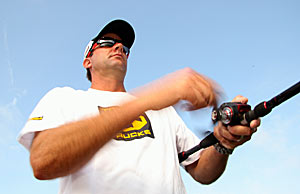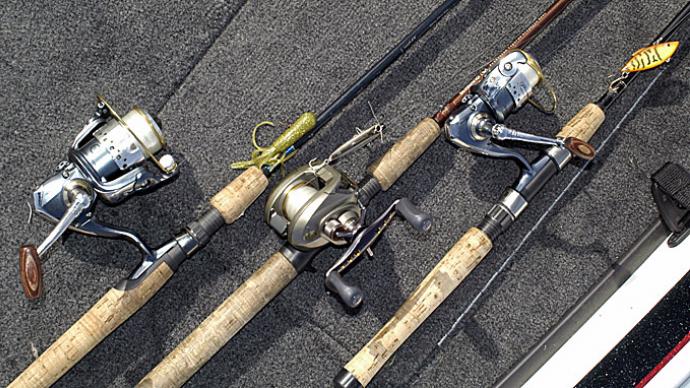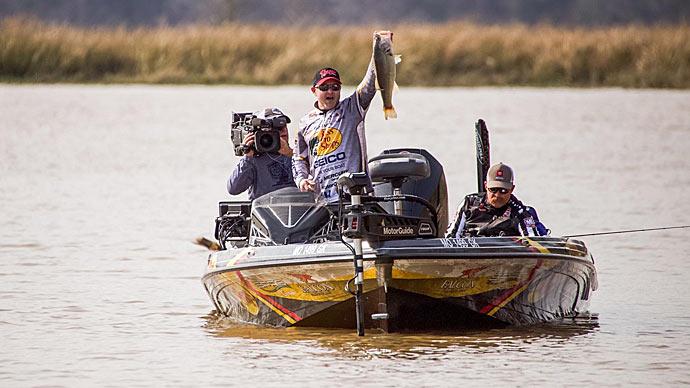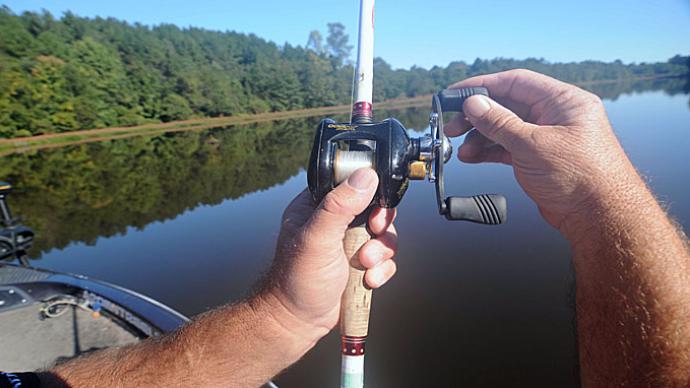
Bass fishing involves the act of continuous action. Casting, jerking, retrieving, lifting, picking out backlashes, and pulling. All these actions, and reactions, can cause significant wear and tear on your body and equipment.
Some of the most important equipment in your fishing arsenal will be the rods and reels you select. Is a $200 rod and reel necessary to catch a bass? No. However, a $200 rod and reel is normally lighter, will cast farther more accurately, and function more efficiently for a longer time than an inexpensive outfit. As with most activities, the more you spend on your tools the more easily, and better, your task can be accomplished. In most sporting activities, the beginner starts with less expensive equipment and then acquires higher quality tools over time. It is very important that as you build your arsenal of equipment and your knowledge of its use is compensatory.
A rod is defined as a tube or shaft mounted with guides, handle, reel seat, and ferrules used to cast a lure to a fish. A rod may consist of one or more connecting sections, but rarely exceeds three. The length of a rod depends on a variety of special conditions, and normally ranges from five to eight feet. Bass rods are progressively tapered from the butt to the tip with a round cross-section.
The advent of the fiberglass rod changed fishing. although the fiberglass rod is still used under certain conditions, it has yielded during the last 20 years to graphite. The light weight and sensitivity of the graphite rod still makes it the choice of anglers.
There are three general functional types of rods for bass fishing; casting, spinning, and fly rods. although fly-fishing for bass is an excellent sport, we are not going to examine its merits in this article.
Casting Rods
Casting rods are designed to accomplish a variety of bass fishing methods. If you polled 10 professional anglers and asked them to select their favorite rod, each would probably have a different favorite length and action rod. If you were to go into a sporting goods store and request to see a baitcasting rod, you would in turn be asked, "What do you want to use it for." Unless you have a specific use for the rod, you would probably be handed a 6-1/2 to 7-foot, medium action rod. If you are just starting out, that's not a problem. This rod will do a good job in most situations. However, as you increase your skill and knowledge, bass fishing becomes somewhat like golf - you rarely putt with a five iron, and most bass anglers rarely use one rod for all techniques. However, you probably could do most techniques fairly well with the previously mentioned rod.
The diagram at the bottom of this article contains criteria for selecting a casting rod length and action for a variety of bass fishing techniques.
Spinning Rods
Many bass anglers, particularly in the south, overlook the importance of a good spinning rod. Virtually all techniques you can accomplish with a casting rod you can accomplish with a spinning rod. However, most southern anglers use spinning rods to fish light baits, with light line, in light cover conditions.
Generally speaking, a light action 5- to 5-1/2-foot, and medium 6- to 6-1/2-foot spinning rod will accomplish most of your bass fishing requirements. The light 5- to 5-1/2-foot spinning rod is good to use on small, or light, baits (i.e. less than 1/8-ounce in weight). Examples of baits that fish best on light spinning rods would include small spinners, grubs, 4-inch worms, small crankbaits, tubes, and crappie jigs. All of these baits can be fished very effectively in open water on a light weight spinning rod with 4- to 8-pound line.
The 6- to 6-1/2-foot spinning rod is used on many of the same lures around somewhat heavier vegetation or brush. Generally 8- to 10-pound line would be more appropriate. A split-shot, drop-shot, or wacky rig are also effectively fished with a medium action-spinning rod.
Gear Ratio
Most manufacturers make reels with several different ratios. The 5:1 ratio reel means the spool of the reel will make five complete revolutions with one complete revolution of the reel handle.
Reels with low ratios are ideal for lures that require a slow retrieve. Most crankbaits work well with a reel with a 5: 1 ratio, while other lures such as a lipless crankbait are best fished with a 6.2:1 ratio reel.
Some anglers fish exclusively with reels that have a 6.2:1 ratio, and feel that they can simply reel slower when they are fishing a lure that requires a slower retrieve. Other anglers feel that they lose the sensitivity that a fast retrieve offers when they try this method.
Another consideration is the amount of line that is brought in with each turn of the handle. A reel that has a full spool, and a gear ration of 4:1 retrieves about 18 inches of line with each turn of the handle. A reel with a 5:1 ratio will retrieve 22 inches of line, and a reel with 6.2:1 will retrieve 28 inches of line with each turn of the reel handle.
Baitcasting Reels
The modern day high-tech reel is available with every option, even one that reels in your fish (electric reel). Deciding which options you need relates primarily to how much you want to spend. A moderately priced $50 to $100, baitcasting reel should contain at least two or three bearings. Low gear ratios (less than 5:1) are not recommended. A reel with a gear ratio of 5:1 is good for heavy lures, or lures with a lot of resistance whereas a 6.3:1 gear ratio is a good choice for most lures.
Line capacity on a reel is not as important in bass fishing as in some other types of fishing. Most reels will hold in excess of 100 yards of 12- pound line, which is ample line storage.
The weight of a reel is important since hand fatigue will play an important roll in a full day of fishing. Most bass reels weigh between eight and 12 ounces, with the lighter reels preferred.
The amount of line recovered per handle revolution is also important. This value usually relates closely to gear ratio. Your reel needs to recover at least 21 inches of line per revolution, or you will be winding like heck and moving no line. Many good fish are lost each year because the angler cannot catch up to the fish to set the hook or keep the fish out of cover.
Baitcasting reels utilize a star drag. although all reels contain a drag, few anglers learn how to use it and most tend to tighten them down all the way. This is the best way to lose a good fish.
Most baitcasters are supposed to be infinite anti-reverse. This simply means there is no slack in the backward direction once the reel is engaged. This varies widely among reels.
Some reels have magnetic anti-backlash control systems. They work, if you learn how to use them.
Finally, casting reels are either right or left-handed (not changeable like spinning reels). It is suggested you find out which way you prefer prior to purchasing your reel. If you are right handed, it is best to reel with your left hand. However, most anglers cannot do this, so check it out first.
Spinning Reels
Spinning reels use a method of casting, and fishing, distinguished from casting in that the spool is fixed. Unlike the level-wind baitcasting reel in which inertia must be overcome by the momentum of the lure being cast, a fixed spool offers no initial resistance thereby eliminating the chief cause of backlash.
Since there is no inertia to overcome at the start of the cast, extremely light lures can be easily cast. The advantages to a beginner are that they can learn to cast in a fraction of the time it takes on a baitcaster.
There are two types of spinning reels: closed-face and open-faced. Most advanced anglers prefer the open-face reel to the closed. The preference is due primarily to higher gear ratio.
Spinning reels come in a variety of weights. Six- to ten-ounce reels are best for bass fishing. As in casting reels, gear ratio controls the speed at which you retrieve a lure. A spinning reel should have at least a 4:1 gear ratio. The gear ratio combined with the spool diameter controls how much line can be retrieved with one revolution of the handle. A minimum of 15 inches per reel revolution is a must, 20 inches or more is better.
Spinning reels have changeable handles so you can reel with either hand.
Many of the same parameters that applied to casting reels such as pick-up points, anti-reversal, etc. also apply to spinning reels. The drag on spinning reels is more efficient than the drag on casting reels. Since you are normally using fairly light line (6- to 10-pound test), the drag is very important. Most spinning reels come with a front or rear drag.
As with most of your bass fishing equipment, proper maintenance can make all of the difference in acceptable performance. Reels should be wiped down after each use and stored in a dry place. It is recommended that reels be disassembled and cleaned at least once a year. Rods should be inspected regularly for cracked or broken guides and cracks or nicks in the rod. Rods should be stored in a rod box or rod holder between uses.
| SELECTING A CASTING ROD | ||
| Fishing Techniques | Heavy Cover/Heavy Baits | Light Cover/Light Baits |
| Jigs, Texas-rigged worms or tubes | 6-1/2 to 7-1/2-foot, (6-8 action) | 6 to 7-foot (4-6 action) |
| Carolina Rig | 7-1/2-foot (6-7 action) | 7-foot (4-6 action) |
| Hard or Soft Jerkbait | 6-1/2 to 7-foot (5-6 action) | 6 to 7-foot (2-4 action) |
| Split Shot/Drop Shot | Not suggested | 6 to 6-1/2-foot, (2-4 action) |
| Wacky style | Not suggested | 6 to 6-1/2-foot (2-3 action) |
| Deep diving crankbait | 6-1/2 to 7-foot (3-4 action) | 6 to 7-foot (3-4 action) |
| Lipless or shallow diving crankbait | 6-1/2 to 7-1/2-foot (5-7 action) | 6 to 7-foot (2-4 action) |
| Spinner or Buzzbait | 6-1/2 to 7-foot (4-6 action) | 6 to 7-foot (3-4 action) |
| Topwaters | 6 to 7-foot (4-5 action) | 6 to 7-foot (2-4 action) |
| Spoons/Tail Spinners | 6 to 7-foot (4-5 action) | 6 to 6-1/2-foot (2-4 action) |
| Oversized baits (1 ounce or more) | 6-1/2 to 7-1/2-foot (6-8 action) | 6-1/2 to 7-1/2-foot (6-8 action) |




